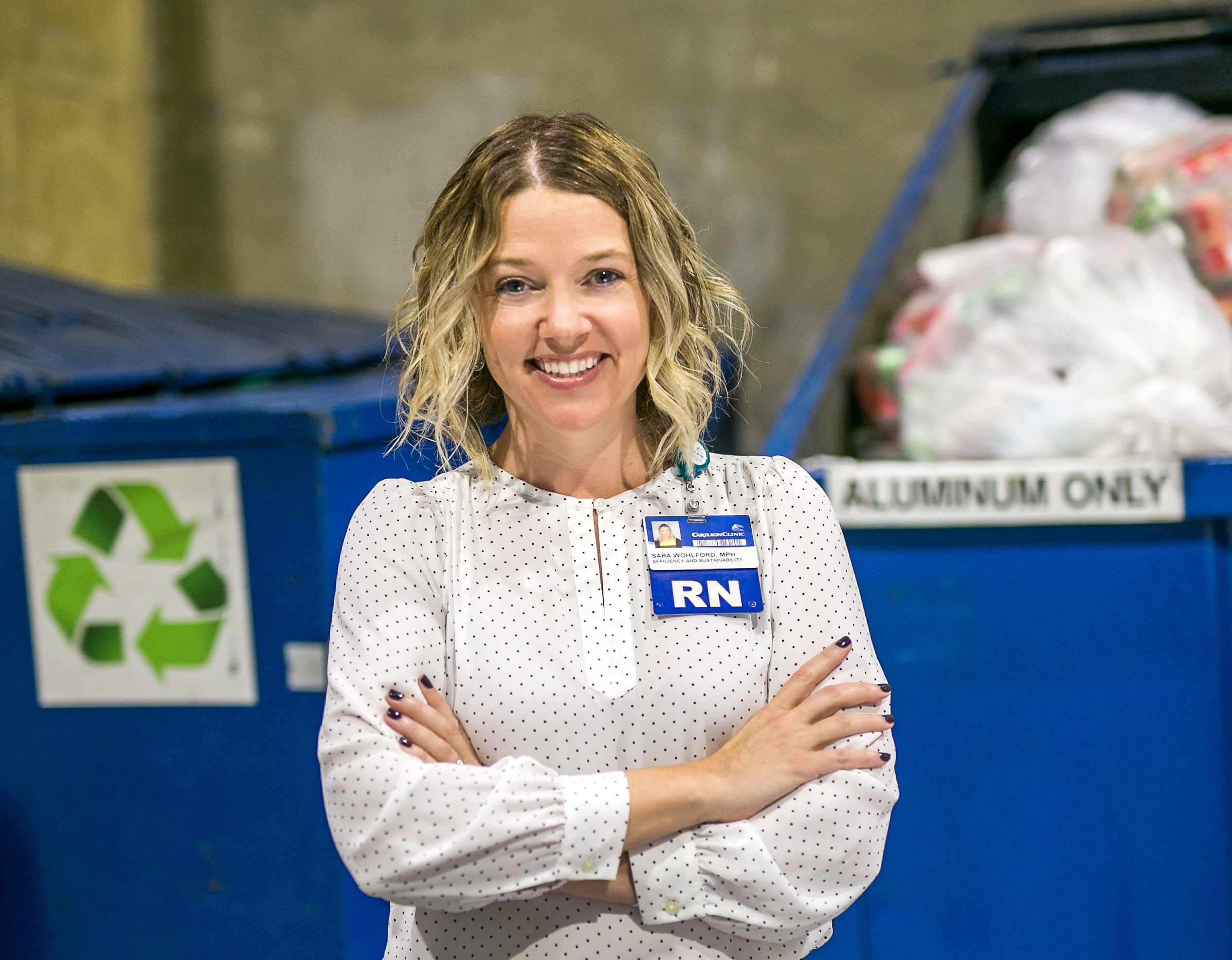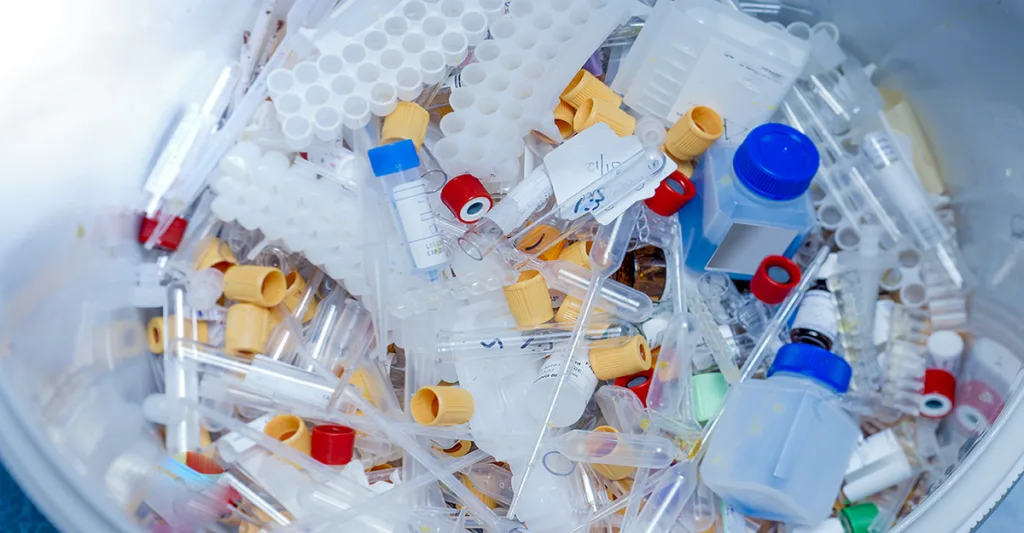From bloody gauze to radioactive materials, nurses work to keep themselves and patients safe from medical waste.
Whenever a nurse cares for a patient, regardless of the specialty or healthcare setting, medical waste is generated. According to a June 2020 article by Practice Greenhealth, a nonprofit organization dedicated to positive environmental stewardship in healthcare organizations, hospitals produce an average of nearly 30 pounds of waste per person each day. Amid the COVID-19 pandemic, with more disposable personal protective equipment (PPE) being used, waste has increased, the organization notes. [caption id="attachment_77460" align="alignleft" width="300"] Sara Wohlford, RN[/caption] Nurses often interact with all types of that waste. "Pretty much every type of waste that there is in healthcare, nurses come into contact with it," said Sara Wohlford, MPH, RN, Efficiency and Sustainability Manager at Carilion Clinic in Roanoke, Va. The role of nurses to safely dispose of waste is not just important to their personal safety, but also to the health and safety of patients and the bottom line of healthcare facilities. "What nursing has done really well when it comes to waste, especially during this time of COVID-19," Wohlford said, "is taking a really hard look at everything they're using and disposing of and making sure that they are properly protected and their patients are properly protected." Nurses also focus on the impact of costs. "Nursing is really concerned about not generating extra waste that's going to just cost their patients and their healthcare system money," Wohlford said.
Sara Wohlford, RN[/caption] Nurses often interact with all types of that waste. "Pretty much every type of waste that there is in healthcare, nurses come into contact with it," said Sara Wohlford, MPH, RN, Efficiency and Sustainability Manager at Carilion Clinic in Roanoke, Va. The role of nurses to safely dispose of waste is not just important to their personal safety, but also to the health and safety of patients and the bottom line of healthcare facilities. "What nursing has done really well when it comes to waste, especially during this time of COVID-19," Wohlford said, "is taking a really hard look at everything they're using and disposing of and making sure that they are properly protected and their patients are properly protected." Nurses also focus on the impact of costs. "Nursing is really concerned about not generating extra waste that's going to just cost their patients and their healthcare system money," Wohlford said.
Types of Medical Waste
The World Health Organization calls the medical waste generated each day diverse with the potential to be hazardous.
The WHO says 85% of medical waste, however, is non-hazardous general waste. The other 15% is considered regulated medical waste, according to Wohlford, and is "typically more of your biohazardous waste. An example would be anything such as bloody gauze or if there are (adult undergarments) patients wear that have an excessive amount of feces or urine in them."
Among the types of medical waste the WHO defines on its website are as follows:
- General waste: Non-hazardous materials that do not present any particular hazard.
- Infectious waste: Materials contaminated with blood or bodily fluids and waste from patients with infections.
- Pathological waste: Examples can include human tissues, organs, or fluids.
- Chemical waste: WHO says this can include solvents, disinfectants, and heavy metals contained in medical devices, such as batteries.
- Cytotoxic waste: This type includes hazardous substances that can be carcinogens, such as cytotoxic drugs used in cancer treatment.
- Radioactive waste: According to the University of Pittsburgh's Radiation Safety Office, this can include contaminated materials or syringes used in nuclear medicine procedures or waste generated from radiation oncology or Positron Emission Tomography (PET) scanning.
- Sharps waste: This category includes syringes, needless, disposable scalpels, and blades.
- Pharmaceutical waste: WHO defines this as "expired, unused, and contaminated drugs and vaccines."
How Nurses Stay Safe
Sharps and pharmaceutical and general non-hazardous waste are among the most common types. No matter the type of waste, proper disposal is crucial for the safety of nurses and patients. Most healthcare facilities have boxes for sharps disposal in patient rooms. An important safety concern is not overfilling the boxes before they are locked, removed and destroyed by a waste service. The boxes ensure that sharps "stay in the room, and you're not walking down the hall with an exposed sharp," Wohlford said. Like other types of waste, Wohlford notes that pharmaceuticals can range from non-hazardous items such as antibiotics and blood pressure medications to hazardous materials that can include blood thinners, opioids, pain medications, and controlled substances.
"If it's not disposed of properly, it can be detrimental to the environment or dangerous to public health," she said.
Nurses should pay close attention to how their facility separates waste to ensure proper handling and safety down the line by others. "It's not just our hands," Wohlford said. "There are many more hands that follow. Always keep that in perspective." Safety also is important when nurses are sorting waste. "With regulated medical waste, the No. 1 thing I encourage from a safety perspective is once it goes into that container, you do not put your hands in there and pull it out," said Wohlford, who offered the example of a family member throwing a cup into the incorrect container. Along with the WHO, several federal organizations have resources and guidance on how nurses can stay safe on the job. These include:
- The Occupational Safety and Health Administration, known as OSHA, offers safety guidelines in its Bloodborne Pathogens Standard.
- The federal Environmental Protection Agency has published "Model Guidelines for State Medical Waste Management."
- A state-by-state overview of needle safety legislation can be found on the National Institute for Occupational Safety and Health (NIOSH) website.
- The Centers for Disease Control and Prevention (CDC) offers teaching tools on sharps safety and a guide to design, implement and evaluate an injury prevention program.
- The International Council of Nurses has published a position statement on the role of nurses in regard to medical waste.
Although the federal government does not regulate medical waste, some states do. Nurses also can discover more information by reviewing policies and standards their own facilities have in place.
Make an Impact
Having a positive effect on medical waste can be thought of in simple terms, according to Wohlford. She encourages nurses to consider how their actions personally - and as a profession - can have a large impact. "It's very easy for nurses to think that throwing away this one extra thing really doesn't matter," she said. "When you talk about a workforce of millions of nurses, and you think how many millions of touches there are on supplies and single-use disposable items, I would encourage nursing to know that every single thing we touch has it's own unique life cycle and unique impact on the environment. "Each individual step matters," she said.






